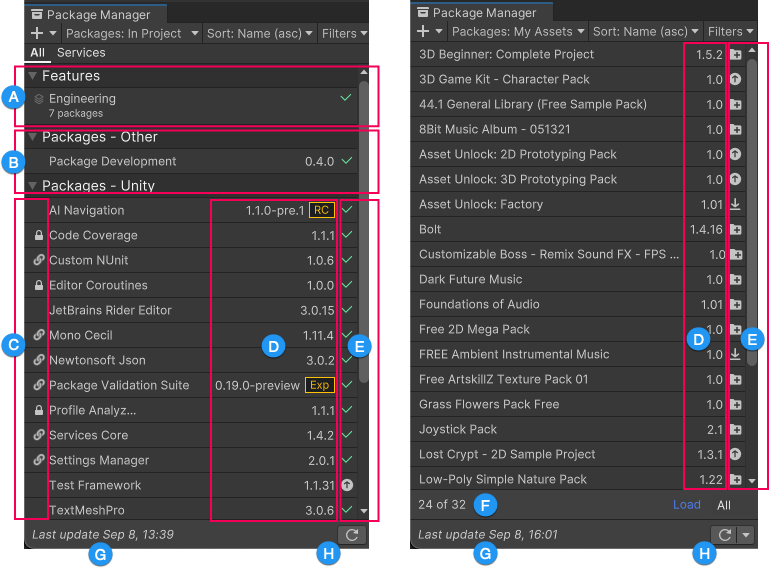列表视图
The Package Manager window displays the list of feature sets, packages, or Asset Store packages according to the criteria that you select by filtering, including, or searching:

(A) Feature sets appear at the top of the list view, indicated with the feature set icon (![]() ). Toggle the expander icon to show or hide the list of feature sets. When you select a feature set from the list, details about it appear on the right, including a brief description, a list of included packages, and a link to the QuickStart guide for that feature set.
). Toggle the expander icon to show or hide the list of feature sets. When you select a feature set from the list, details about it appear on the right, including a brief description, a list of included packages, and a link to the QuickStart guide for that feature set.
(B) Registry groups organize the list of packages installed in your project (or available for installation when you are in the My Registries context). Select the expander on the left to show or hide the list of packages for each registry.
(C) Icons display in this column when a package is locked (![]() ) or installed as a dependency (
) or installed as a dependency (![]() ), and more.
), and more.
(D) The package version displays the version of the package that’s installed. If the package is not yet installed, the version that appears is the recommended version. Special icons often appear beside the version number indicating its state:
-
 Released
Released
-
 Release Candidate
Release Candidate
-
 Pre-release
Pre-release
-
 Experimental
Experimental
-
 Custom (embedded)
Custom (embedded)
对于 Asset Store 资源包,显示的版本是您已经下载的版本或者是可以从 Asset Store 下载的版本。
(E) These icons display the status of the package or Asset Store package:
| 图标 (Icon): | 描述 |
|---|---|
| A check mark indicates that the package or feature set is already installed or enabled. Note: Installed Asset Store packages display the import icon ( |
|
| The update icon indicates that the package has an available update. To update your package, follow the instructions for either type of package: - For Unity packages, see Switching to another package version. - For Asset Store packages, see Updating your Asset Store package. - Feature set versions are fixed to the Editor version and can’t be updated. |
|
| 导入图标表示有一个可供导入的 Asset Store 资源包。在项目中导入 Asset Store 资源包后,也会出现该图标。 | |
| 下载图标表示有一个可供下载的 Asset Store 资源包。 | |
| 错误图标表示在安装或加载过程中出现问题。有关解决错误的更多建议,请参阅错误消息。 |
(F) The My Assets context displays a counter showing the number of Asset Store packages available but not shown in the list. To load more Asset Store packages, click the Load link.
Note: If you select the My Assets context but you don’t see any packages, see Error messages in the Package Manager window for an explanation and solution.
(G) The status bar displays messages about the package load status and network warnings.
(H) Click the reload ![]() button to force Package Manager to reload your packages and feature sets.
button to force Package Manager to reload your packages and feature sets.
By default, the Package Manager window displays the list of all packages and feature sets available in the selected context, but you can filter the list to display packages and feature sets that meet your criteria. While viewing the Unity Registry or In Project context, you can also switch from the All tab to the Services tab to display services only.
You can also include pre-release packages in the list and search for a specific package or feature set by name (ID) or display name.